[ad_1]
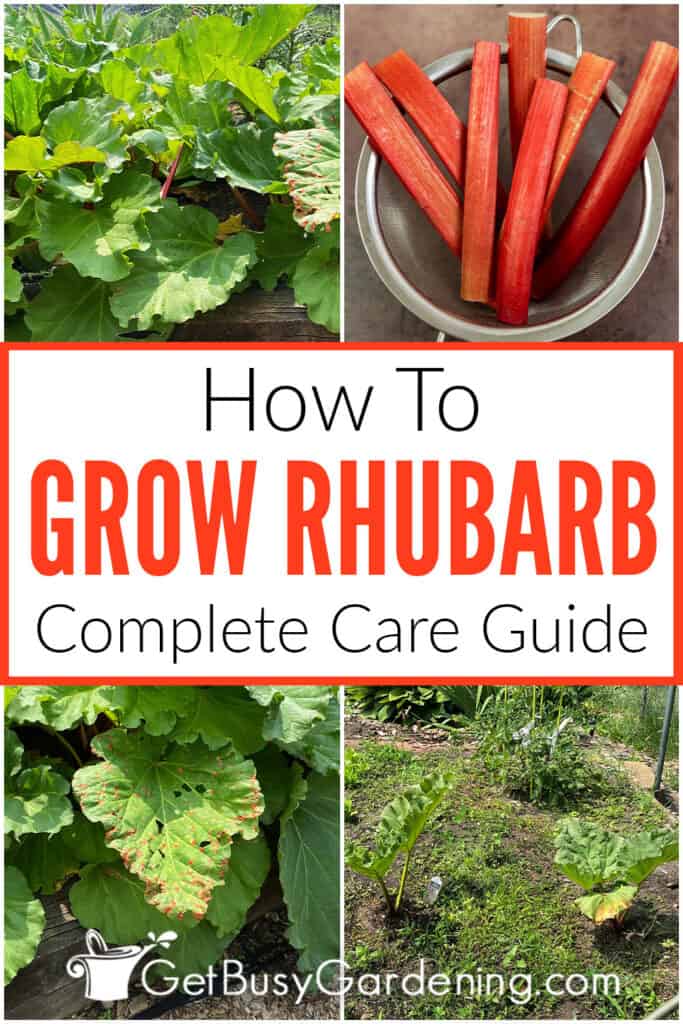
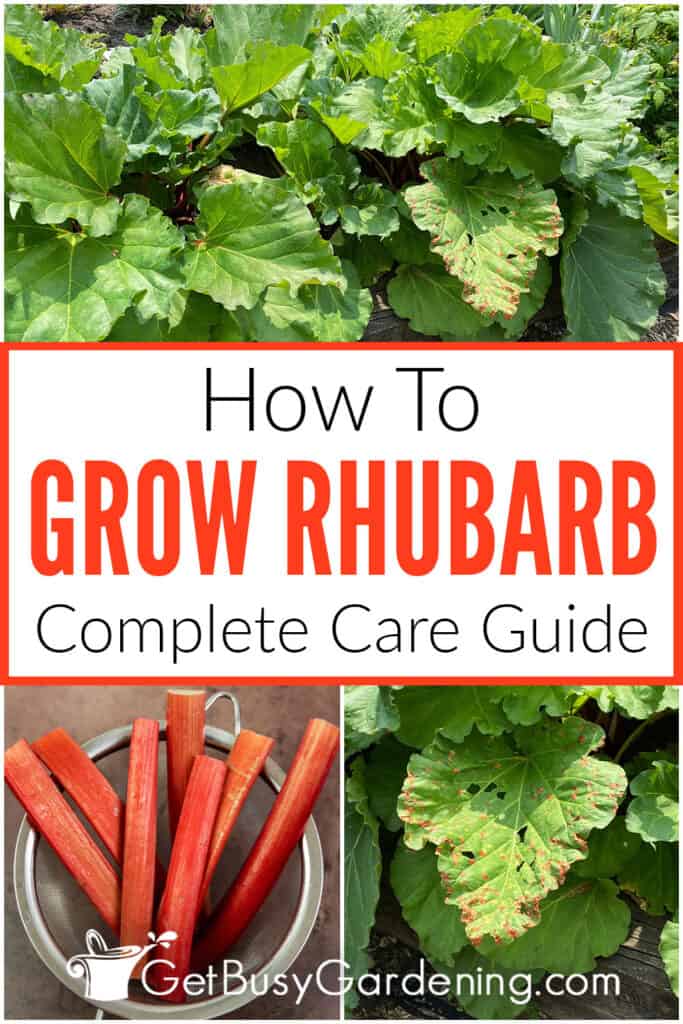


Rhubarb is simple to develop, and a very good alternative for inexperienced persons and consultants alike. Particularly if you need a low-maintenance choice to your vegetable backyard.
This hardy perennial is a staple for a lot of long-time gardeners. However, to achieve success, you could first perceive methods to look after it accurately.
On this information, I’ll inform you every part you have to find out about rising your personal rhubarb, it doesn’t matter what your talent degree. You’ll discover the entire important details about soil, water, fertilizer, solar, temperature, pest management, and far more.
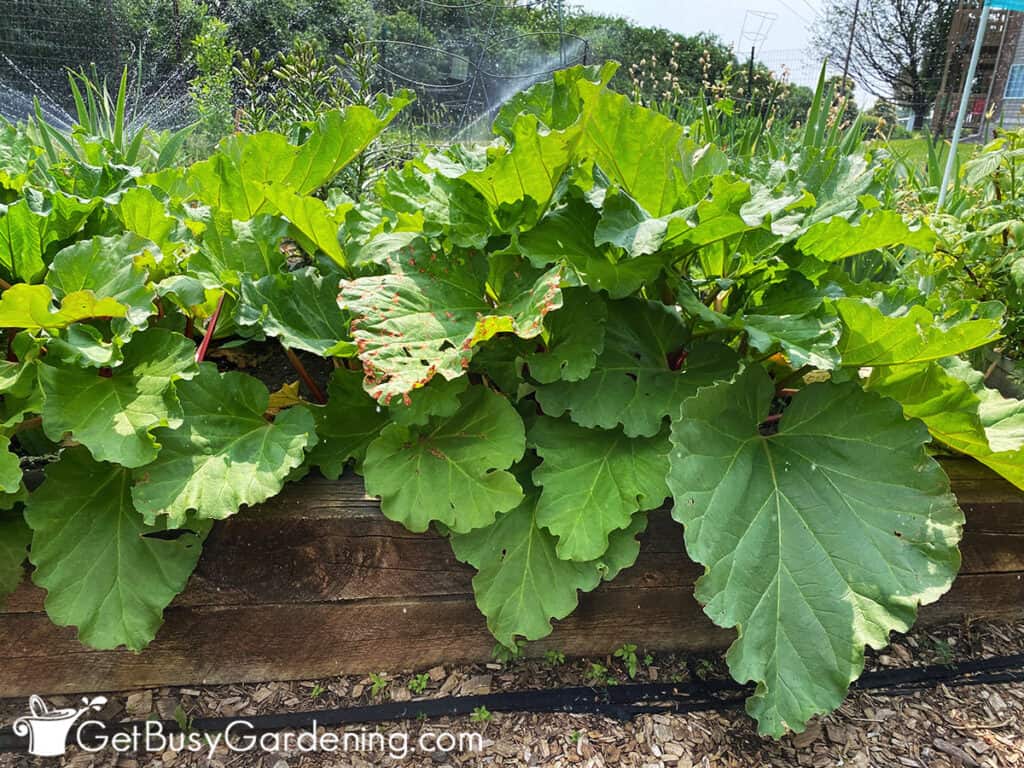

Table of Contents
ToggleFast Rhubarb Plant Care Overview
Data About Rhubarb
Rhubarb (Rheum rhabarbarum) is a perennial vegetable native to Asia that’s been cultivated worldwide for lots of of years.
It has lengthy stalks, or ribs, with massive inexperienced leaves on the high. A mature plant will be 4’ huge or bigger and have stalks which can be pink, pink, or inexperienced.
The leaves include oxalic acid, which makes them poisonous and inedible (supply). However gardeners love the stalks for his or her bitter, tart taste. They’re well-liked in baking, preserves, desserts, and sauces.
These low-maintenance vegetation hardly ever has pest or illness issues, they usually can proceed to provide for 8-15 years.
Completely different Sorts
There are lots of kinds of rhubarb with variations in hardiness, stem colour, dimension, and progress fee. However fortunately, all of them will be cared for in the identical manner. Listed here are a couple of of the preferred varieties:
Canada Pink – This plant has shorter stalks which can be pink inside and outside, and extra tender than different varieties.
Riverside Large – This slow-growing, cold-hardy selection produces lengthy inexperienced stems.
Macdonald – The lengthy, tender pink stalks on this selection are juicy and fewer tart, making it a well-liked choice.
Victoria – This is among the most favored cultivars as a result of slight sweetness and tender stalks, which have pink exteriors and inexperienced interiors.
Hardiness
Rhubarb is a really chilly hardy perennial that can come again yearly in zones 3-8. Temperatures as little as -20°F (-28°C) gained’t harm it.
In truth, it wants the chilly to provide new stalks yearly. You’ll have a tough time rising rhubarb if it doesn’t get beneath freezing the place you reside.
How Does Rhubarb Develop?
The edible fibrous stalks develop from buds that kind across the crown or rootball. Every year, clusters of recent buds develop on the surface of the earlier 12 months’s, steadily inflicting the plant to turn into wider.
Giant, broad inexperienced leaves develop from the highest of every stalk. On mature vegetation, tiny clusters of flowers can develop on tall spikes within the spring.
Because it warms up in the summertime, the stalks will get thinner and shorter because the plant focuses on storing power for subsequent 12 months’s bounty.
Associated Submit: How To Make Rhubarb Jam: Simple Recipe
The place To Develop Rhubarb
Within the cooler zones of 3-5, select a full solar location to encourage the quickest progress. Within the hotter zones of 6-8, discover a spot that will get partial shade within the afternoon to guard it from the new solar.
For finest outcomes, the mattress ought to have has wealthy, fertile, and well-draining soil. An space that stays persistently moist, however not overly moist, can be good.
When To Plant
Plant your Rheum rhabarbarum as quickly as the bottom is workable within the early spring. You can begin it from seed, however it can take a number of years to achieve full maturity.
Dig deep holes and fill them with compost or a well-rotted manure. Add a slow-release fertilizer, then plant the crown 1-2” underneath the soil.
A single rhubarb plant will develop wider over time, so be certain that to house them 3-4’ aside so that they have loads of room, and don’t turn into overcrowded.

Rhubarb Plant Care & Rising Directions
Now that you’ve the proper location in thoughts, it’s time to speak about methods to look after rhubarb your plant. My suggestions beneath will assist make it a straightforward addition to your backyard.
Daylight
Rhubarb wants 6-8 hours of daylight to provide wholesome stalks, and to make sure the crown has sufficient power shops to develop again yearly.
Select a full-sun location, until you reside in a heat local weather (zones 6-8). In that case, present shade within the afternoon in the course of the hottest a part of the day to stop sunburn.
Water
Whereas it may possibly deal with brief intervals of drought, rhubarb grows finest with constant moisture, and it doesn’t wish to dry out for too lengthy. Water deeply when the highest 1” of soil is dry.
Give it a deep soaking, however by no means to the purpose the place the water swimming pools or the bottom is soggy, as a result of an excessive amount of can result in crown rot.
Mulch across the base of the plant to assist retain moisture, particularly in the summertime when temperatures rise. Compost, hay, or shredded bark will work nice for that. Cease watering within the fall when the foliage dies off because the plant enters its dormant interval.
Associated Submit: How To Can Rhubarb At Dwelling
Temperature
These chilly hardy vegetation don’t like the warmth, and can develop probably the most within the spring and early summer season when it’s between 40-75°F (4.4-23.9°C). Something hotter could cause drought stress, wilting, bolting, or scorching.
Cooler temperatures will set off the plant to go dormant within the fall and winter. However that’s a very good factor, as a result of it wants a relaxation interval beneath 40°F (4.4°C) to provide new stalks the next spring.
Fertilizer
Rhubarb is a heavy feeder and can profit from common functions of a balanced general-purpose vegetable fertilizer from spring by means of summer season.
Use an all-purpose liquid twice a month spring by means of early summer season, or top-dress with slow-release granules earlier than it breaks dormancy within the spring.
In early spring, top-dress with compost or well-rotted manure, then work slow-release granules into the soil month-to-month. Or apply a liquid like compost tea or fish emulsion each two weeks.
Soil
One of many issues that makes rhubarb really easy to look after is that it may possibly develop in nearly any kind of soil, so long as it’s well-draining. However the ultimate combine is wealthy, fertile, porous, and loamy
It also needs to be barely acidic, or between 6-6.8 on a ph probe. In case your soil is alkaline, you possibly can amend it with a slow-release acidifier.
You possibly can enhance poor-quality backyard soil by digging a deep gap earlier than planting, and including compost or well-rotted manure, in addition to slow-release fertilizer granules into it. Or you possibly can top-dress your vegetation.
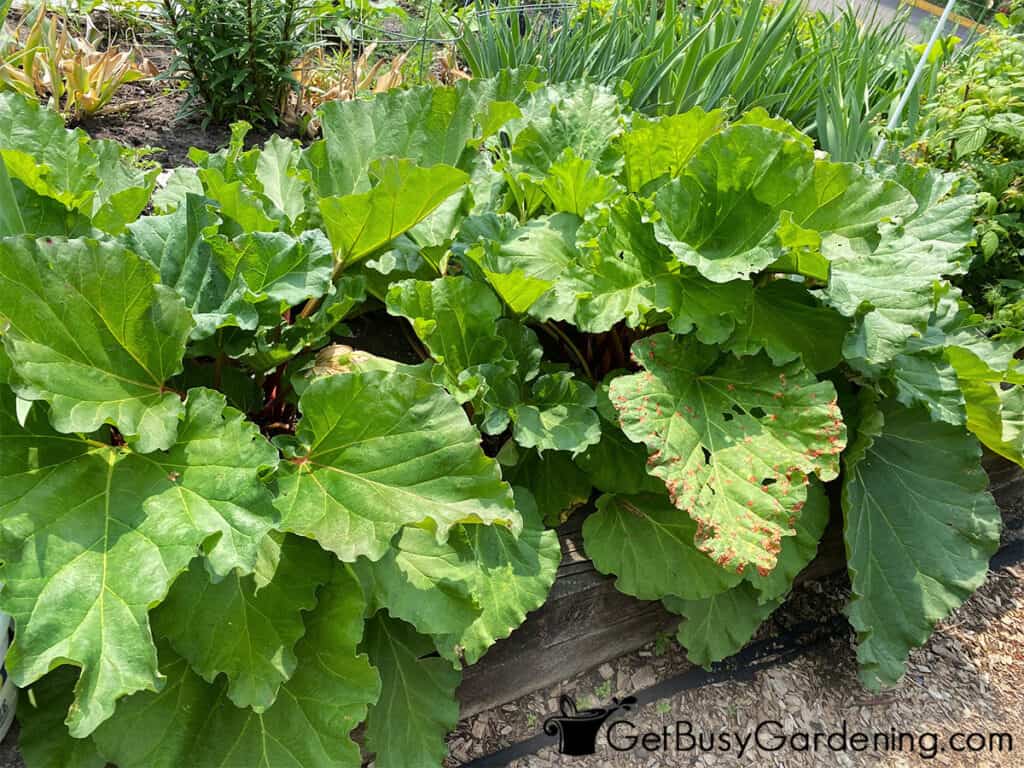
Pruning
You don’t want to fret about pruning your rhubarb, it can develop simply wonderful with out it. However common trimming might help preserve the looks and management the scale of the plant.
Take away lifeless or broken stems by merely twisting or chopping them off. Use sharp pruning shears to snip away the flower stalks as they seem, to permit the plant to divert the power again into the crown to retailer for subsequent 12 months.
Propagation
In case your rhubarb is older than 5 years, you possibly can take away new clusters or divide the crown within the late winter or early spring, whereas the plant remains to be dormant.
Use a pointy, sterile backyard knife to separate them, and ensure every part accommodates at the least one bud. Share them with buddies, or replant them with loads of house to develop.
Pest Management Ideas
Although they’re often pest-free vegetation, the rhubarb curculio beetle enjoys feeding and laying eggs on the stems.
These pesky bugs overwinter in plant particles and lifeless leaves, so be certain that to scrub up your backyard within the fall to assist stop them.
Holes and oozing sap within the stalks are indicators of an infestation. Hand-pick the bugs off the plant and drop them right into a bucket of soapy water to eliminate them.
Illness Management Ideas
Crown rot is a standard drawback in heavy, poor-draining soils, and is often attributable to overwatering. The principle signs are wilting, yellowing leaves, and gentle stems.
Leaf spot is a fungus that may unfold from water or wind. It causes pink, yellow, or brown round lesions on the leaves. Hold the bottom away from previous plant particles and water on the base to stop splashing on the leaves.
When you discover spots on any of the foliage, take away and destroy the contaminated ones instantly to maintain the illness from spreading.
Ideas For Harvesting Rhubarb
You possibly can start flippantly harvesting your rhubarb within the second 12 months of progress by eradicating only a few of the bigger outer stalks.
By the third 12 months, you possibly can take away as much as ⅓ of the plant with every harvest as quickly because the stalks attain 12-18” tall.
One of the simplest ways to select it’s by holding a stem firmly in your hand and twisting it from the bottom. Take away the leaves instantly and discard them. They’re inedible and can make the stalks gentle when you go away them on for too lengthy.
Associated Submit: How To Freeze Rhubarb (With Or With out Blanching)
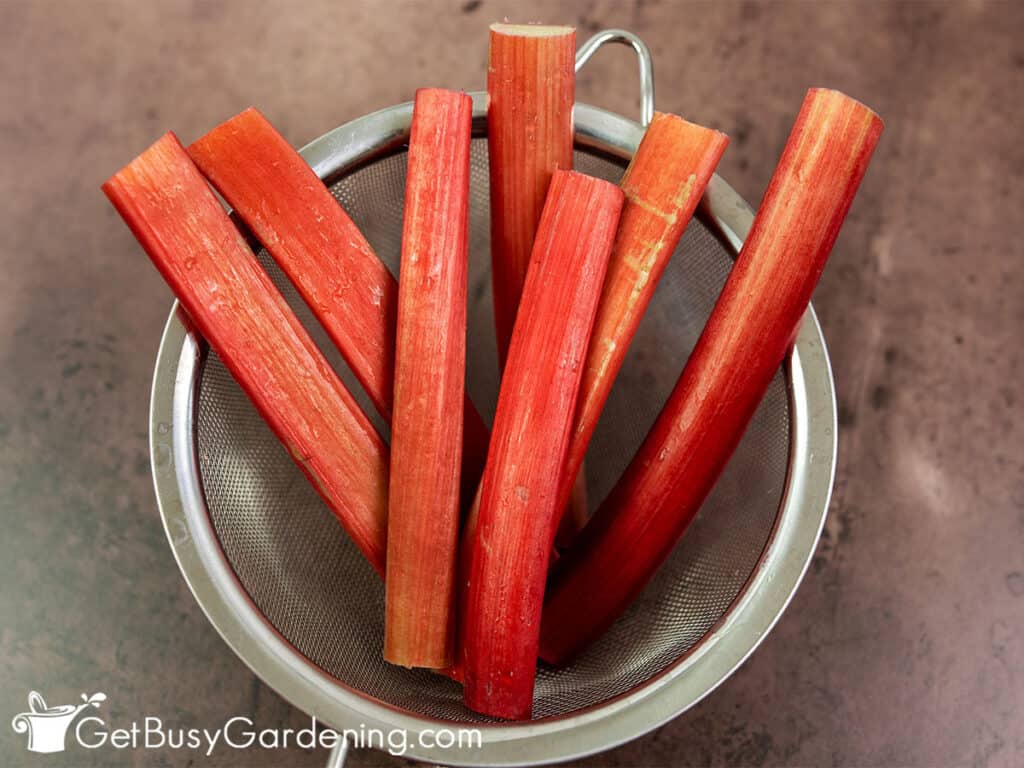
Troubleshooting Widespread Issues
Rhubarb is low-maintenance and barely has points, however no plant is problem-free. When you encounter one among these extra frequent points, my suggestions will get you again on observe.
Skinny, Spindly Stalks
Lack of sunshine, vitamins, or age can all trigger skinny stalks. In case your rhubarb plant is in full solar, attempt fertilizing it with add an all-purpose liquid or gradual launch granules.
If solar and vitamins aren’t the problem, and your plant is between 5-10 years previous, it could be time to divide it. You possibly can rejuvenate it by chopping the crown into sections, or by eradicating and transplanting the brand new bud clusters.
Brown Spots On Leaves
Leaf spot, a fungal illness, is commonly the reason for brown recognizing on rhubarb leaves. It will probably come from moisture sitting on the foliage, poor airflow, or previous plant particles.
The most effective strategy is to take away any affected leaves and destroy them. Hold the plant’s base clear, keep away from overhead watering, and ensure your vegetation aren’t overcrowded.
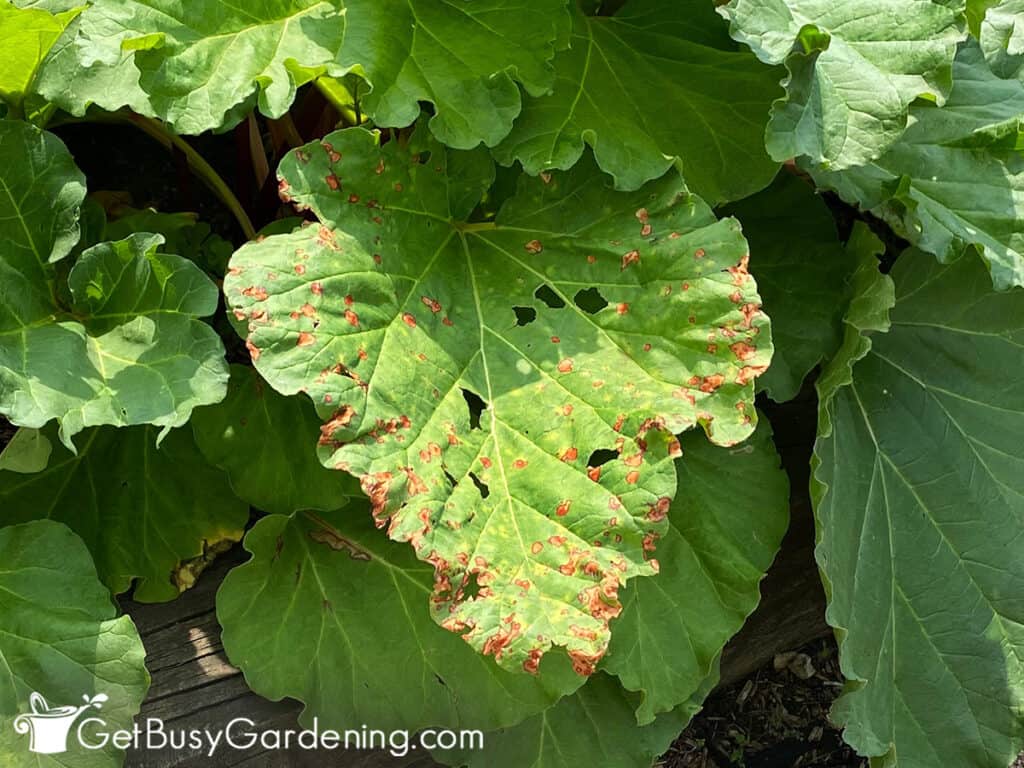
FAQs
Rhubarb grows rapidly, however will not be harvestable till the 2nd or third 12 months, relying on the precise selection you’ve got.
Rhubarb doesn’t unfold by producing offshoots or runners, however annually the plant will develop wider as new buds develop across the outdoors of the crown.
Sure, rhubarb is simple to develop as a result of it tolerates a variety of soils, is pest and disease-resistant, cold-hardy, and it requires little or no consideration.
Rhubarb is a vegetable. Folks typically mistake it for a fruit as a result of it’s regularly utilized in candy recipes, like jams, jellies, and desserts to offset the bitter taste.
Rhubarb is a hardy perennial plant that can return yearly in zones 3-8. It doesn’t do properly in hotter climates as a result of it wants a chilly winter to provide plenty of thick, edible stalks.
Sure, rhubarb vegetation will come again yearly in rising zones 3-8.

When you’d wish to discover ways to take advantage of your house and get as a lot homegrown meals as potential, then my Vertical Greens ebook is ideal! It is going to educate you all you have to know, has tons of attractive pictures, and consists of 23 DIY initiatives you possibly can construct to your personal backyard. Order your copy at present!
Be taught extra about my Vertical Greens ebook right here.
Extra About Vegetable Gardening
Share your suggestions for rising rhubarb within the feedback part beneath.

[ad_2]
Supply hyperlink